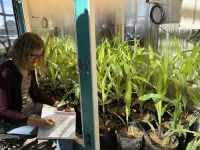(Press-News.org) Integrating sensors into rotational mechanisms could make it possible for engineers to build smart hinges that know when a door has been opened, or gears inside a motor that tell a mechanic how fast they are rotating. MIT engineers have now developed a way to easily integrate sensors into these types of mechanisms, with 3D printing.
Even though advances in 3D printing enable rapid fabrication of rotational mechanisms, integrating sensors into the designs is still notoriously difficult. Due to the complexity of the rotating parts, sensors are typically embedded manually, after the device has already been produced.
However, manually integrating sensors is no easy task. Embed them inside a device and wires might get tangled in the rotating parts or obstruct their rotations, but mounting external sensors would increase the size of a mechanism and potentially limit its motion.
Instead, the new system the MIT researchers developed enables a maker to 3D print sensors directly into a mechanism’s moving parts using conductive 3D printing filament. This gives devices the ability to sense their angular position, rotation speed, and direction of rotation.
With their system, called MechSense, a maker can manufacture rotational mechanisms with integrated sensors in just one pass using a multi-material 3D printer. These types of printers utilize multiple materials at the same time to fabricate a device.
To streamline the fabrication process, the researchers built a plugin for the computer-aided design software SolidWorks that automatically integrates sensors into a model of the mechanism, which could then be sent directly to the 3D printer for fabrication.
MechSense could enable engineers to rapidly prototype devices with rotating parts, like turbines or motors, while incorporating sensing directly into the designs. It could be especially useful in creating tangible user interfaces for augmented reality environments, where sensing is critical for tracking a user’s movements and interaction with objects.
“A lot of the research that we do in our lab involves taking fabrication methods that factories or specialized institutions create and then making then accessible for people. 3D printing is a tool that a lot of people can afford to have in their homes. So how can we provide the average maker with the tools necessary to develop these types of interactive mechanisms? At the end of the day, this research all revolves around that goal,” says Marwa AlAlawi, a mechanical engineering graduate student and lead author of a paper on MechSense.
AlAlawi’s co-authors include Michael Wessely, a former postdoc in the MIT Computer Science and Artificial Intelligence Laboratory (CSAIL) who is now an assistant professor at Aarhus University; and senior author Stefanie Mueller, an associate professor in the MIT departments of Electrical Engineering and Computer Science and Mechanical Engineering, and a member CSAIL; as well as others at MIT and collaborators from Accenture Labs. The research will be presented at the ACM CHI Conference on Human Factors in Computing Systems.
Built-in sensing
To incorporate sensors into a rotational mechanism in a way that would not disrupt the device’s movement, the researchers leveraged capacitive sensing.
A capacitor consists of two plates of conductive material that have an insulating material sandwiched between them. If the overlapping area or distance between the conductive plates is changed, perhaps by rotating the mechanism, a capacitive sensor can detect resulting changes in the electric field between the plates. That information could then be used to calculate speed, for instance.
“In capacitive sensing, you don’t necessarily need to have contact between the two opposing conductive plates to monitor changes in that specific sensor. We took advantage of that for our sensor design,” AlAlawi says.
Rotational mechanisms typically consist of a rotational element located above, below, or next to a stationary element, like a gear spinning on a static shaft above a flat surface. The spinning gear is the rotational element and the flat surface beneath it is the stationary element.
The MechSense sensor includes three patches made from conductive material that are printed into the stationary plate, with each patch separated from its neighbors by nonconductive material. A fourth patch of conductive material, which has the same area as the other three patches, is printed into the rotating plate.
As the device spins, the patch on the rotating plate, called a floating capacitor, overlaps each of the patches on the stationary plate in turn. As the overlap between the rotating patch and each stationary patch changes (from completely covered, to half covered, to not covered at all), each patch individually detects the resulting change in capacitance.
The floating capacitor is not connected to any circuitry, so wires won’t get tangled with rotating components.
Rather, the stationary patches are wired to electronics that use software the researchers developed to convert raw sensor data into estimations of angular position, direction of rotation, and rotation speed.
Enabling rapid prototyping
To simplify the sensor integration process for a user, the researchers built a SolidWorks extension. A maker specifies the rotating and stationary parts of their mechanism, as well as the center of rotation, and then the system automatically adds sensor patches to the model.
“It doesn’t change the design at all. It just replaces part of the device with a different material, in this case conductive material,” AlAlawi says.
The researchers used their system to prototype several devices, including a smart desk lamp that changes the color and brightness of its light depending on how the user rotates the bottom or middle of the lamp. They also produced a planetary gearbox, like those that are used in robotic arms, and a wheel that measures distance as it rolls across a surface.
As they prototyped, the team also conducted technical experiments to fine-tune their sensor design. They found that, as they reduced the size of the patches, the amount of error in the sensor data increased.
“In an effort to generate electronic devices with very little e-waste, we want devices with smaller footprints that can still perform well. If we take our same approach and perhaps use a different material or manufacturing process, I think we can scale down while accumulating less error using the same geometry,” she says.
In addition to testing different materials, AlAlawi and her collaborators plan to explore how they could increase the robustness of their sensor design to external noise, and also develop printable sensors for other types of moving mechanisms.
This research was funded, in part, by Accenture Labs.
###
Written by Adam Zewe, MIT News Office
Additional background
Paper: “MechSense: A Design and Fabrication Pipeline for Integrating Rotary Encoders into 3D Printed Mechanisms.”
https://www.dropbox.com/s/3yrp0jvadtzu46w/mechsense.pdf?dl=0
END
3D-printed revolving devices can sense how they are moving
A new system enables makers to incorporate sensors into gears and other rotational mechanisms with just one pass in a 3D printer.
2023-03-17
ELSE PRESS RELEASES FROM THIS DATE:
Tackling gambling harm among Armed Forces veterans
2023-03-17
Swansea University News Release
17 March 2023
£1 million for projects involving Swansea experts to tackle gambling harm among Armed Forces veterans
Research to tackle gambling harm among Armed Forces veterans has received a major boost with three awards, totalling £1 million, for new projects in the field that involve Swansea University experts.
The projects include evaluating a smartphone app for veterans with gambling disorder and PTSD, which is aimed at reducing symptoms,
The three projects ...
Rivers and streams in the Andean Cordillera are hot spots for greenhouse gases emissions
2023-03-17
A new scientific study by researchers from the University of Liège (Belgium) shows that rivers in the Andean mountains contribute 35% and 72% of riverine emissions of carbon dioxide (CO2 ) and methane (CH4 ) in the Amazon basin, the world's largest river. This study is published in the journal Communications Earth & Environment.
Rivers contribute substantially to global emissions of carbon dioxide (CO2) and methane (CH4). The Amazon River, the World's largest river, plays an important role in greenhouse gas (GHG) emissions. It is the largest river on the planet in terms of freshwater flow," explains Alberto Borges, ...
Dual-task walking performance may be an early indicator of accelerated brain aging
2023-03-17
Boston, MA -- Walking is a complex task that is most commonly performed while completing other tasks like talking, reading signs, or making decisions. For most, after the age of 65, such “dual tasking” worsens walking performance and may even cause unsteadiness. Intriguingly, older adults that are more affected by dual tasking are at higher risk of suffering adverse health outcomes, including both falls and dementia.
A new research study published in Lancet Healthy Longevity has reported that the ability to dual task when walking starts to decline by the age of 55, up to a decade before ‘old ...
New study counts the environmental cost of managing Japanese knotweed
2023-03-17
New Swansea University research has looked at the long-term environmental impact of different methods to control Japanese knotweed.
The invasive species has been calculated to cost more than £165 million to manage every year in the UK alone. Its presence can blight property purchases for households across the country.
This has led to the development of different ways of trying to control it but with sustainability becoming increasingly important, understanding the effect of these management methods is vital.
A new study, led by biosciences lecturer Dr Sophie Hocking and looking ...
Discovery of an unexpected function of blood immune cells : Their ability to proliferate !
2023-03-17
The ability of a cell to divide, to proliferate, is essential for life and gives rise to the formation of complex organisms from a single cell. It also allows the replacement of used cells from a limited number of “stem” cells, which then proliferate and specialize. In cancer, however, cell proliferation is no longer controlled and becomes chaotic. Researchers from the GIGA Institute at the University of Liège have discovered that, in a healthy individual, certain blood immune cells, the monocytes, ...
Women working rotating shifts especially likely to be frail, York study finds
2023-03-17
March 17, 2023, TORONTO — A new study led by researchers at York University has found a link between shift work and frailty among middle-aged and older workers in Canada, especially for women on rotating shifts.
While there is a large body of research suggesting the disruptions to circadian rhythms that shift workers experience are linked to various illnesses, this study was the first to take a comprehensive or “holistic” look at the connection between shift work and frailty.
“We cannot ignore the negative health outcomes related to shift work, including cardiovascular diseases, ...
Argonne hosts conference for undergraduate women in physics
2023-03-17
The U.S. Department of Energy’s (DOE) Argonne National Laboratory hosted an American Physical Society (APS) Conference for Undergraduate Women in Physics (CUWiP) on Jan. 20-22. The conference series, sponsored by DOE and the National Science Foundation, is designed to support undergraduate women and gender minorities in physics by connecting them with resources, community, information on graduate school and professionals in their field. It also provides students with access to other women in physics with whom they can share experiences, advice and ideas.
The January 2023 event is one of 14 APS CUWiP events hosted across the country and ...
How can we tackle the biggest challenges? Ask a plant
2023-03-17
LOS ALAMOS, N.M., March 16, 2023 — Without plants, we’d have no air to breathe or food to eat, yet plant science lingers in the shadowy wings while other fields take center stage. With the goal of shining the spotlight on plants, a new study presents the field’s top 100 most pressing questions for research to address the greatest challenges facing humanity.
“The study highlights the importance of plant science for society by laying out myriad questions and technical challenges ...
Genes shed light on why men and women experience different depression symptoms
2023-03-17
Depression is widely reported to be more common in women than in men, with women twice as likely to receive a diagnosis than men. A new sex-specific study from McGill University has found that there are differences between male and female genes and how they relate to depression. In a study of more than 270,000 individuals, the researchers found that sex-specific prediction methods were more accurate in forecasting an individual’s genetic risk of developing depression than prediction methods that did not specify sex. The researchers found ...
Breaking barriers in hepatitis C diagnosis and treatment for populations at risk
2023-03-17
A study with people who inject drugs evaluated a minimally invasive test based on dried blood spots (DBS) for the monitoring of hepatitis C virus (HCV) infection. The use of DBS samples for HCV RNA detection and genotyping was shown to effectively assess cure after treatment and to differentiate between reinfection and treatment failure. The results support the viability of decentralizing treatment and post-treatment monitoring for people who inject drugs, who frequently face challenges accessing the healthcare system. The study, which has been published in the Journal of Medical Virology, was carried out as part of a project with support from the "Conquering ...
LAST 30 PRESS RELEASES:
World-first discovery uncovers how glioblastoma tumours dodge chemotherapy, potentially opening the door to new treatments
A fatal mix-up: How certain gut bacteria drive multiple sclerosis
New AI tool identifies not just genetic mutations, but the diseases they may cause
Deep-learning model predicts how fruit flies form, cell by cell
Combination pills for high blood pressure may simplify treatment, improve long-term health
Immune system keeps mucosal fungi in check
Neurons within the brain use simple rules to localize genetic messages
Electrodes created using light
Second-hand gift-giving is a well-deliberated decision
How human interaction drove evolution to make bears less aggressive
National Poll: Few parents offer teens guidance on healthy eating during holiday season
Cannabis derivatives could provide new ovarian cancer treatments
Raising strong yeast as a petroleum substitute
Clues to the origin of hot Jupiters hidden in their orbits
Canada’s reduced pledge to Global Fund will impact domestic health
1 in 4 children with major traumatic injuries not cared for in pediatric trauma centres
Duke and Duke-NUS’ joint cross-population research to uncover "East-West" differences in disease and care
Scientists to ‘spy’ on cancer- immune cell interactions using quantum technology breakthrough
Tech savvy users have most digital concerns
Making lighter work of calculating fluid and heat flow
Normalizing blood sugar can halve heart attack risk
Lowering blood sugar cuts heart attack risk in people with prediabetes
Study links genetic variants to risk of blinding eye disease in premature infants
Non-opioid ‘pain sponge’ therapy halts cartilage degeneration and relieves chronic pain
AI can pick up cultural values by mimicking how kids learn
China’s ecological redlines offer fast track to 30 x 30 global conservation goal
Invisible indoor threats: emerging household contaminants and their growing risks to human health
Adding antibody treatment to chemo boosts outcomes for children with rare cancer
Germline pathogenic variants among women without a history of breast cancer
Tanning beds triple melanoma risk, potentially causing broad DNA damage
[Press-News.org] 3D-printed revolving devices can sense how they are movingA new system enables makers to incorporate sensors into gears and other rotational mechanisms with just one pass in a 3D printer.








